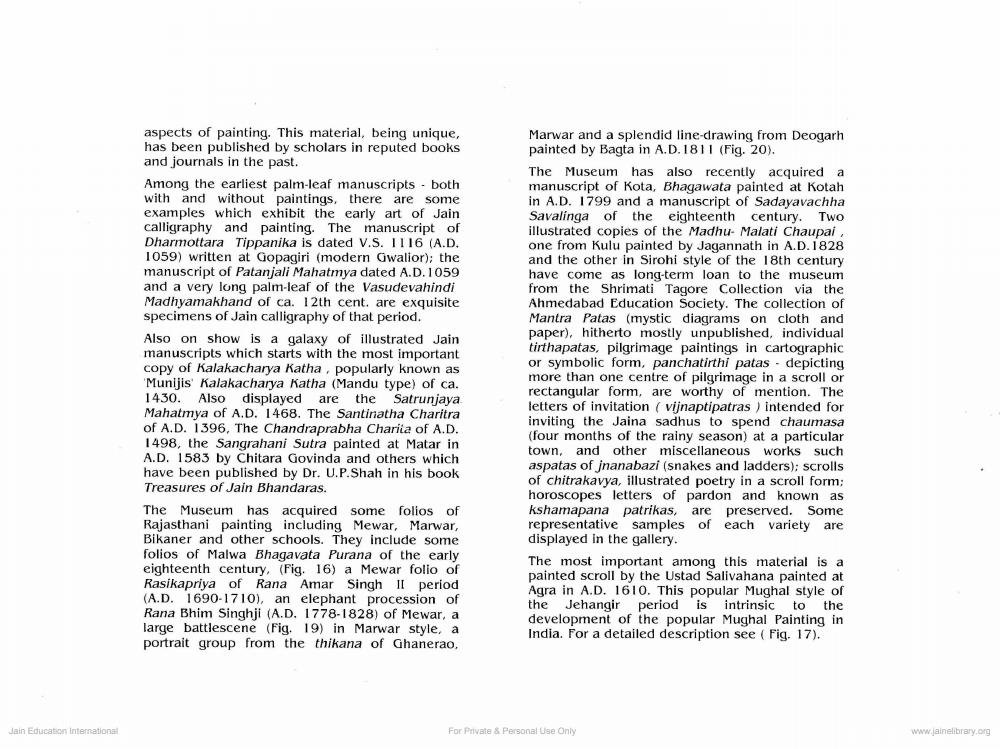________________
Jain Education International
aspects of painting. This material, being unique, has been published by scholars in reputed books and journals in the past..
Among the earliest palm-leaf manuscripts - both with and without paintings, there are some examples which exhibit the early art of Jain calligraphy and painting. The manuscript of Dharmottara Tippanika is dated V.S. 1116 (A.D. 1059) written at Gopagiri (modern Gwalior); the manuscript of Patanjali Mahatmya dated A.D. 1059 and a very long palm-leaf of the Vasudevahindi Madhyamakhand of ca. 12th cent. are exquisite specimens of Jain calligraphy of that period.
Also on show is a galaxy of illustrated Jain manuscripts which starts with the most important copy of Kalakacharya Katha, popularly known as 'Munijis Kalakacharya Katha (Mandu type) of ca. 1430. Also displayed are the Satrunjaya Mahatmya of A.D. 1468. The Santinatha Charitra of A.D. 1396, The Chandraprabha Charita of A.D. 1498, the Sangrahani Sutra painted at Matar in A.D. 1583 by Chitara Govinda and others which have been published by Dr. U.P.Shah in his book Treasures of Jain Bhandaras.
The Museum has acquired some folios of Rajasthani painting including Mewar, Marwar, Bikaner and other schools. They include some folios of Malwa Bhagavata Purana of the early eighteenth century, (Fig. 16) a Mewar folio of Rasikapriya of Rana Amar Singh II period (A.D. 1690-1710), an elephant procession of Rana Bhim Singhji (A.D. 1778-1828) of Mewar, a large battlescene (Fig. 19) in Marwar style, a portrait group from the thikana of Ghanerao.
Marwar and a splendid line-drawing from Deogarh painted by Bagta in A.D. 1811 (Fig. 20).
The Museum has also recently acquired a manuscript of Kota, Bhagawata painted at Kotah in A.D. 1799 and a manuscript of Sadayavachha Savalinga of the eighteenth century. Two illustrated copies of the Madhu Malati Chaupai, one from Kulu painted by Jagannath in A.D. 1828 and the other in Sirohi style of the 18th century have come as long-term loan to the museum from the Shrimati Tagore Collection via the Ahmedabad Education Society. The collection of Mantra Patas (mystic diagrams on cloth and paper), hitherto mostly unpublished, individual tirthapatas, pilgrimage paintings in cartographic or symbolic form, panchatirthi patas depicting more than one centre of pilgrimage in a scroll or rectangular form, are worthy of mention. The letters of invitation (vijnaptipatras) intended for inviting the Jaina sadhus to spend chaumasa (four months of the rainy season) at a particular town, and other miscellaneous works such aspatas of jnanabazi (snakes and ladders); scrolls of chitrakavya, illustrated poetry in a scroll form; horoscopes letters of pardon and known as kshamapana patrikas, are preserved. Some representative samples of each variety are displayed in the gallery.
The most important among this material is a painted scroll by the Ustad Salivahana painted at Agra in A.D. 1610. This popular Mughal style of the Jehangir period is intrinsic to the development of the popular Mughal Painting in India. For a detailed description see (Fig. 17).
For Private & Personal Use Only
www.jalnelibrary.org




